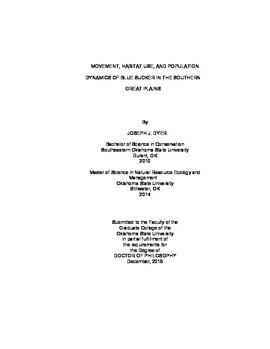| dc.contributor.advisor | Brewer, Shannon K. | |
| dc.contributor.author | Dyer, Joseph J | |
| dc.date.accessioned | 2019-07-19T13:33:31Z | |
| dc.date.available | 2019-07-19T13:33:31Z | |
| dc.date.issued | 2018-12-01 | |
| dc.identifier.uri | https://hdl.handle.net/11244/320930 | |
| dc.description.abstract | Freshwater migratory fishes are among the most imperiled taxa in the world. However, mobile life histories make the study and conservation of migratory fishes challenging. The undefined scope of movement and habitat use often limit conservation efforts for the species. Fishes occupying large rivers are inherently difficult to capture and problematic to evaluate. Blue Sucker Cycleptus elongatus is an emblematic large-river migratory fish with a broad spatial distribution and considered a species of conservation concern in North America. I evaluated the movement patterns, habitat use, population dynamics, and the effect of variable flow and temperature on the recruitment and somatic growth of Blue Suckers. I determined that both resident and migratory populations exist within my study area. Blue Suckers were more likely to return to spawn during wet years and displayed spawning-site fidelity more frequently than they strayed. Blue Suckers that strayed, most often selected the only undammed tributary in the system. Additionally, I determined that Blue Suckers were most likely to spawn in conjunction with high flows that occurred in the late winter and early spring. I found that Blue Suckers were most likely to occur near riffles in the tributaries during the spawning season. My assessment of population dynamics of Blue Suckers in two flow-regulated streams indicated that the population was stable at one location and declining at the other location. In my assessment of the effects of flow and temperature on the recruitment and somatic growth of Blue Sucker, I estimated that growing seasons with high flows followed by declining flows resulted in strong recruitment the following spring. This indicates that summer conditions in the Red River were important for gonadal growth, although I did not detect a relationship between environmental conditions and somatic growth. Finally, I found a relationship between conditions in the undammed tributary and recruitment in the Red River. This indicates that preserving the natural flow of that tributary and its connectivity with the Red River is important to the conservation of Blue Sucker. | |
| dc.format | application/pdf | |
| dc.language | en_US | |
| dc.rights | Copyright is held by the author who has granted the Oklahoma State University Library the non-exclusive right to share this material in its institutional repository. Contact Digital Library Services at lib-dls@okstate.edu or 405-744-9161 for the permission policy on the use, reproduction or distribution of this material. | |
| dc.title | Movement, Habitat Use, and Population Dynamics of Blue Sucker in the Southern Great Plains | |
| dc.contributor.committeeMember | Shoup, Daniel E. | |
| dc.contributor.committeeMember | Grabowski, Timothy B. | |
| dc.contributor.committeeMember | Dzialowski, Andrew R. | |
| osu.filename | Dyer_okstate_0664D_16066.pdf | |
| osu.accesstype | Open Access | |
| dc.description.department | Natural Resource Ecology and Management | |
| dc.type.genre | Dissertation | |
| dc.type.material | Text | |
